‘Metropolis’: exhibiting the sights and sounds of Karachi
KARACHI: The ever sprawling and vibrant Karachi has been interpreted in complex and unusual fashion at the Habib University artists-in-residence show titled 'Metropolis' that is open till Saturday evening (today).
The exhibition is the outcome of an art project that brought together artists from Lahore, Islamabad and the United Kingdom who stayed for four weeks here in Karachi with their studios on the HU campus and focused on sights and sounds of the sprawling metropolis in their artwork.
The four visiting artists namely Mina Arham from Lahore, Abeerah Zahid from Islamabad and Fari Bradley and Chris Weaver from Britain used different techniques and mediums to express how they view Karachi’s expansion.
The project is the collaborative effort of HU, Lahore Biennale Foundation and the British Council.
 |
| Visitors at the exhibit. — Photo courtesy: Nadeem Abbas, HU |
Mina intricately used miniature art to encapsulate the city by working on buildings and concrete structures that helped her in drawing parallels to Lahore: “Initially my work has been to document landscape like Karachi, Lahore or Islamabad to see the underlying similarities between different cities. In this one, I focused on Karachi’s landscape by comparing it with Lahore’s as to how they vary."
"However in a separate piece, I have made a very small drawing, because it is very difficult to capture Karachi’s vastness and get that feeling of how it is expanding with buildings overlapping," she continued. "In this, everything seems planned and the unplanned aspect disappears. Being a fast moving city, Karachi is not intimate and it is so overwhelming that there is no intimacy between the individual and the city so I wanted to create that so I have taken Saddar which now looks like a walled city.”
 |
| Rolled drawings show how the work has now been stopped in the middle just like Karachi, where one unfinished building is followed by another. — Photo by author |
Explaining another piece, Mina talked about how a process came about that was both planned and unplanned and was a part of the larger framework. For her, the rolled drawings show how the work has now been stopped in the middle just like Karachi, where one unfinished building is followed by another.
Abeerah, who used drawings and structural pieces to reflect her thoughts, spoke about how at every visit she felt that there was less of the sky. Using the plastic helmet worn by construction workers with cemented iron rods, Abeerah wanted the onlookers to feel the growing structures effect that is not present in other cities such as Islamabad.
“I always feel that the buildings are on top of my head, I can’t see them but they’re always present which makes me wonder as to how are so many buildings getting constructed at the same time. The drawings represent the landing strip of airport as well as what I saw from my studio. I have placed them together so they come as one landscape.”
 |
| Abeerah's drawings on display. — Photo courtesy: Jamal Ashiqain |
With studios near the airport, the artists used planes in a different way, while Mina’s work reminds one of Karachi being a war zone, Abeerah’s shows a smooth takeoff.
Fari Bradley and Chris Weaver, who hail from Britain, have portrayed Karachi via drawings, sculptures and very fascinating sound art while taking a different approach to the pulsating city.
 |
| Saddar encapsulated as a walled city. — Photo courtesy: Jamal Ashiqain |
Elucidating about her body of work that also comprised noisy, steel truck-art boxes, Bradley said: “We took something that had to do with the main arteries of the city. So we picked trucks as they’re thundering through the city and we took some recognizable truck art that is elegant as well as childlike: a box.”
The boxes, reachable for children, help them interact with the art as each box has different sounds that changes with a different touch. “We wanted to comment on the innocence and childhood of the children on the streets of Karachi that we see in the traffic, on the roads,” Bradley explained.
 |
| Sound artist, Chris Weaver fixes a box. — Photo courtesy: Jamal Ashiquain |
Two highly intriguing boxes, ‘innocence’ and ‘shame’ caught attention of many visitors. According to Bradley, the boxes also alluded to the tale of a Pandora’s box because in this society things are more closed. “Shame is what keeps the box closed, you feel ashamed and a lot of things happen to you that are not your faults and even if you make mistakes, you have right to do so because you learn from them, for me opening up, and facing them.”
Her illustrations reflected her various thoughts and one of them was the wires depicted as musical notes showing the rise and fall as well as struggle of classes.
Another installation of sound art in the form of videos also drew the visitors who were keen to know the source of the sounds as slow videos with a bird flying past only showed different times via a skyline.
 |
| Abeerah's construction helmet representing the unfinished structures. — Photo by author |
For Chris Weaver, the idea behind his work was to bring out the various sounds in Karachi. “We recorded the soundscape of Karachi, the markets, military salute at Jinnah’s mausoleum. There are three videos — morning, afternoon and sunset — and computers randomly choose the noise and produce new sounds and while these slow videos unfold the actual time, the soundscape is like a fake Karachi.”
Saima Zaidi, the curator of the three-day group show, said: “The title, Metropolis, was kept generic so it is open-ended and I have noticed that whenever artists from outside Karachi come here they have a different way of paying attention to the city. We had visual as well as sound artists and with their work we learnt how to pay attention to the city, not just to the eye but to the ear as well.”
She believed that such projects also helped students in engaging and interacting with the city and could help in overcoming that disconnection with the city.









Comments